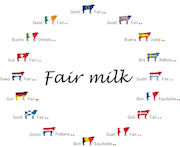 Dairy farmers from more than ten countries, led by the European Milk Board (EMB), gathered in Italy last week to discuss how to take action against rising milk production.The group is unhappy about EU policy, including removal of milk quotas, which has led to an increase in production at a rate that global demand cannot keep up with.
Dairy farmers from more than ten countries, led by the European Milk Board (EMB), gathered in Italy last week to discuss how to take action against rising milk production.The group is unhappy about EU policy, including removal of milk quotas, which has led to an increase in production at a rate that global demand cannot keep up with.
Board EMB
The Board said in a statement that such policies were responsible for the collapse of many dairy farms, and for “doing away with milk production in entire regions”. Romuald Schaber, President of the EMB, said: “No doubt many a politician would be glad if we were to simply stand by and watch as hundreds of thousands of dairy farms collapsed without a word. “But these farms produce healthy food, guarantee jobs, bring rural regions alive and stop them dying out. In this way they make a huge contribution to society. Last but not least they are our life.”
Farmers
The farmers were unanimous in demanding that production is decreased slightly instead of stepped up in times of crisis. They advocated voluntary production cuts as the way to achieve this, as detailed in EMB’s Market Responsibility Programme (MRP). At the meeting, the EMB highlighted the extremely difficult situation faced by many European dairy farmers, as another cost study was released showing that cost of production is below the farmgate price in Italy.
This follows previous studies of cost of production in Germany, France, Belgium, the Netherlands and Denmark. The studies include an amount to be paid to farm workers, allowing them to work out the cost of production when a fair standard of living is provided to farmers.
Italy
Italy’s results show costs averaging 42.61 cents/kilo of milk for 2014. When EU subsidies are deducted from this, the amount is 38.92 cents. Although the farm-gate price for milk was 39.64 cents in the record price year of 2014, for months now the price has not stopped falling, and is currently 34.49 cents, leaving Italy’s dairy farmers significantly out of pocket. The costs were calculated using publicly available EU data, and was commissed jointly between EMB and the Italian producer organisation Associazione Produttori Latte della Pianura Padana (APL).
Thanks to TheDairySite.com for this summary.

